A great opportunity to help birds and have fun at the same time is coming up between February 12 and 15 via The Great Backyard Bird Count (GBBC), a “citizen-science project” jointly run by the Cornell Lab of Ornithology and the National Audubon Society. For this annual event, people from around the world submit online counts of the birds they see each day of the Presidents Day holiday weekend. You enter all the species you saw at a given location and the number of individuals of each species. You can start by grabbing a cup of shade-grown, bird-friendly coffee in the morning and then just look out your window.
I’ll be doing that, and the species I’m most likely to see here in Ohio include northern cardinal, white-breasted and red-breasted nuthatches, tufted titmouse, black-capped chickadee, red-bellied woodpecker, blue jay, downy woodpecker, American goldfinch, dark-eyed junco, and red-winged blackbird. I might also see a red-tailed hawk buzz the yard. When I’ve finished that coffee and made some notes, I’ll head out to a local park that has a large body of water and some woods to rack up more observations. Then I’ll enter all my sightings into eBird—a huge online database of bird sightings also run by the Cornell Lab of Ornithology—later that day. Fun!

American Goldfinch – Freeimages.com/MariaCorcacas
The data provided by observers are used by scientists, policymakers, advocacy groups, and geeks like me to learn important things about bird populations. Birds are facing increasing challenges from the climate catastrophe as well as increased development, free-roaming cats, windows, windmills, and more. Are bird ranges tending to shift farther north? Are they increasing or decreasing in size? Have the numbers reported of some species declined? Although the observations made during the GBBC provide just an annual “snapshot” of where bird species are and what their numbers are, the event has been held since 1998, so the data are very valuable and revealing when compared across time.
And eBird is easy to use. You might even start entering data on a regular basis after the GBBC is over!

Snowy Owl – Freeimages.com/Andreas Krappweis
Participate in the GBBC and report your regular visitors as well as any unusual birds you spot. Actively viewing free-living birds is fun and can sometimes turn up exciting rarities. So get out there and enjoy yourself, and hopefully, the experience will leave you charged up to help other birds, like those suffering in experiments at Louisiana State University.
Now, where did I leave my binoculars?





